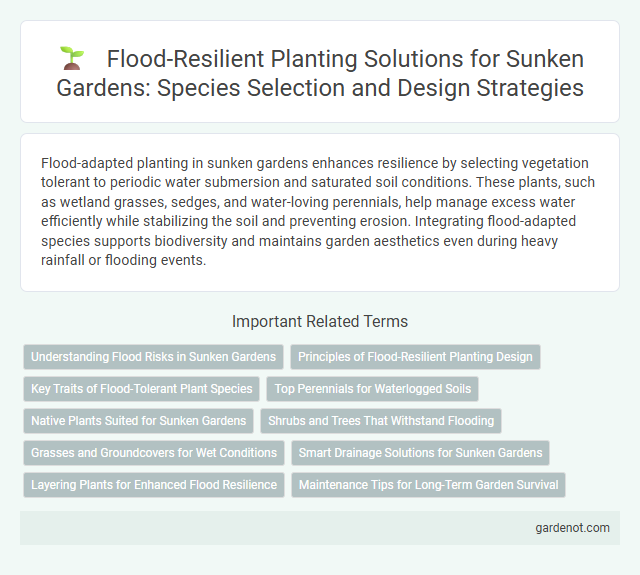Flood-adapted planting in sunken gardens enhances resilience by selecting vegetation tolerant to periodic water submersion and saturated soil conditions. These plants, such as wetland grasses, sedges, and water-loving perennials, help manage excess water efficiently while stabilizing the soil and preventing erosion. Integrating flood-adapted species supports biodiversity and maintains garden aesthetics even during heavy rainfall or flooding events.
Understanding Flood Risks in Sunken Gardens
Flood-adapted planting in sunken gardens requires a thorough understanding of local flood risks, including water depth, duration, and frequency of inundation. Selecting plant species with high tolerance to waterlogging and fluctuating moisture levels enhances garden resilience during floods. Incorporating native hydrophilic plants and adaptive soil management techniques reduces erosion and promotes rapid recovery post-flood events.
Principles of Flood-Resilient Planting Design
Flood-resilient planting design in sunken gardens emphasizes selecting flood-tolerant plant species with deep root systems that stabilize soil and withstand prolonged water saturation. Incorporation of native plants adapted to local hydrology reduces maintenance and enhances ecosystem resilience. Strategic layering of vegetation promotes efficient water absorption and prevents erosion during flood events.
Key Traits of Flood-Tolerant Plant Species
Flood-tolerant plant species in sunken gardens exhibit key traits such as aerenchyma tissue for enhanced oxygen transport, adventitious root formation to maintain stability and nutrient uptake, and the ability to withstand anaerobic soil conditions. These adaptations enable plants like bald cypress (Taxodium distichum) and lotus (Nelumbo nucifera) to thrive in prolonged waterlogged environments. Selecting species with high ethanol tolerance and efficient toxin removal mechanisms ensures resilience against flood-induced stress.
Top Perennials for Waterlogged Soils
Flood-adapted perennials such as Astilbe, Iris versicolor, and Lobelia cardinalis thrive in waterlogged soils, making them ideal for sunken garden landscaping. These plants exhibit resilience to prolonged flooding while providing vibrant blooms and dense foliage that enhance moisture-retentive environments. Selecting perennials with strong water tolerance ensures sustainable growth and aesthetic appeal in flood-prone garden areas.
Native Plants Suited for Sunken Gardens
Flood-adapted planting in sunken gardens thrives with native plants such as swamp milkweed (Asclepias incarnata), joe-pye weed (Eutrochium purpureum), and blue flag iris (Iris versicolor), which naturally tolerate periodic flooding. These species enhance soil stabilization and provide resilient, low-maintenance landscapes that support local biodiversity. Incorporating native flood-tolerant plants ensures sustainable growth and minimizes erosion in water-collecting sunken garden environments.
Shrubs and Trees That Withstand Flooding
Flood-adapted planting in sunken gardens emphasizes selecting shrubs and trees with high tolerance to waterlogged soils and periodic flooding. Species such as bald cypress (Taxodium distichum) and buttonbush (Cephalanthus occidentalis) exhibit exceptional resilience to submerged roots and saturated conditions. Incorporating flood-tolerant plants ensures long-term landscape stability by reducing plant stress and promoting ecological balance in fluctuating water environments.
Grasses and Groundcovers for Wet Conditions
Flood-adapted planting in sunken gardens thrives with grasses and groundcovers specifically suited for wet conditions, such as Carex, Juncus, and Milium species. These plants improve soil stabilization, enhance water absorption, and reduce erosion by tolerating periodic inundation. Incorporating wet-tolerant groundcovers like Lysimachia nummularia and Ajuga reptans maximizes resilience and aesthetic appeal in flood-prone sunken gardens.
Smart Drainage Solutions for Sunken Gardens
Flood-adapted planting in sunken gardens relies on smart drainage solutions such as permeable soil layers and subsurface drainage pipes to efficiently manage excess water. These systems enhance water absorption and prevent waterlogging, supporting plants tolerant to periodic flooding like sedges and rushes. Integrating automated sensors enables real-time monitoring and adaptive water flow control, optimizing garden resilience and plant health during heavy rain events.
Layering Plants for Enhanced Flood Resilience
Layering plants in a sunken garden enhances flood resilience by combining deep-rooted trees, mid-layer shrubs, and groundcover to absorb excess water and stabilize soil. Flood-adapted species like willows, buttonbush, and swamp milkweed create a natural filtration system that reduces erosion and improves water quality. Strategic plant layering also supports biodiversity and ensures recovery after flooding events.
Maintenance Tips for Long-Term Garden Survival
Flood-adapted planting in sunken gardens requires choosing water-tolerant species like swamp milkweed, iris, and pickerelweed to thrive in saturated soils. Regularly inspect and remove debris to prevent waterlogging and ensure proper drainage through well-designed channels or permeable materials. Maintaining soil health with organic mulch and monitoring plant health prevents root rot and promotes long-term garden resilience against flooding stress.
Flood-adapted planting Infographic

 gardenot.com
gardenot.com